Click on images to enlarge
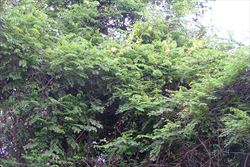
climbing habit (Photo: Sheldon Navie)

scrambling habit (Photo: Sheldon Navie)
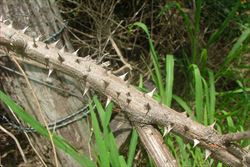
very thorny older stems (Photo: Sheldon Navie)
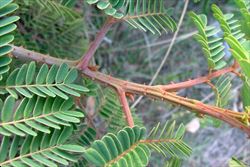
younger stem covered with prickles and rusty hairs (Photo: Sheldon Navie)
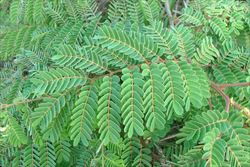
twice-compound leaves (Photo: Sheldon Navie)

elongated flower clusters (Photo: Sheldon Navie)

close-up of yellow flowers (Photo: Sheldon Navie)

immature fruit (Photo: Sheldon Navie)

mature fruit (Photo: Sheldon Navie)
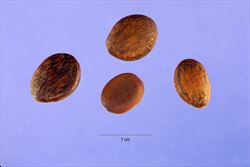
close-up of seeds (Photo: Steve Hurst at USDA PLANTS Database)

seedling (Photo: Sheldon Navie)

the larger leaflets and smaller spiny fruit of the native nicker bean, Caesalpinia bonduc (Photo: Chris Gardiner)

the larger leaflets and bluish-green stems of the native large prickle-vine, Caesalpinia scortechinii (Photo: Sheldon Navie)

climbing habit (Photo: Sheldon Navie)

twice-compound leaves (Photo: Sheldon Navie)

young fruit (Photo: Sheldon Navie)
Scientific Name
Caesalpinia decapetala (Roth) Alston
Synonyms
Caesalpinia sepiaria Roxb.Reichardia decapetala Roth.
Family
Caesalpiniaceae (Queensland, the ACT, Victoria, Tasmania, Western Australia and the Northern Territory) Fabaceae: sub-family Caesalpinioideae (New South Wales)Leguminosae (South Australia)
Common Names
cat's claw, Mauritius thorn, Mysore thorn, shoofly, thorny poinciana, tiger stopper, wait a bit, wait a while, wait-a-bit, wait-a-while, whoa back, whoa-back, woody wait-a-while
Origin
Native to southern and eastern Asia (i.e. India, Bhutan, Sri Lanka, Laos, Myanmar, Indonesia, the Philippines, Thailand, Vietnam, Malaysia, China, Korea and Japan).
Cultivation
This species has been cultivated as an ornamental, and though it is no longer regarded as a useful or popular ornamental species, it may still be occasionally found in old gardens.
Naturalised Distribution
A relatively widespread species that is mainly found in the coastal regions of eastern Australia. It is most common in south-eastern Queensland and north-eastern New South Wales, and less common in the coastal and sub-coastal districts of central and northern Queensland. Also recorded from the coastal regions of central New South Wales and on Norfolk Island. There are also two early collections from Waterfall Gully, in the Mt Lofty Ranges, in south-eastern South Australia in 1908, but it has not been recorded in South Australia since that time.
Overseas records of naturalisation include several Pacific Islands (i.e. Fiji, French Polynesia, Hawaii and New Caledonia), the Mascarenes (i.e. Mauritius, La Réunion and Rodrigues) and South Africa.
Habitat
A weed of forest margins, disturbed forests, wetter bushland areas, waterways (i.e. riparian vegetation), pastures, disturbed sites, old gardens, roadsides and plantation crops in tropical, sub-tropical and warmer temperate regions.
Habit
A large shrub (growing 2-4 m tall) with sprawling prickly branches that forms dense thickets, or more commonly a climber growing up into the canopy of larger trees (up to 20 m high).
Distinguishing Features
- a large sprawling shrub (2-4 m tall) or tall climber with prickly branches.
- these branches are also densely covered with tiny brownish or golden-coloured hairs.
- its twice-compound leaves have a prickly main stalk and 4-10 pairs of branchlets.
- its pale yellow flowers have five petals (10-15 mm long) and are borne in elongated clusters (10-40 cm long) at the tips of the branches.
- its brown, flattened, pods (6-10 cm long and about 25 mm wide) have a small projection at their tips.
Seedling
The two seed leaves (i.e. cotyledons) are generally not seen and may remain below the soil surface (i.e. they may be cryptocotylar). The first pair of true leaves are usually only once compound (i.e. pinnate), with about six pairs of leaflets. All following leaves are usually twice-compound (i.e. bipinnate) with at least two pairs of leaf branchlets (i.e. pinnae). The number of leaf branchlets (i.e. pinnae), and leaflets on each branchlet, increases as the seedlings continue to grow and mature.
Stems and Leaves
The young branches are densely covered with tiny brownish or golden-coloured hairs and have numerous sharp prickles. Older stems are thicker, greyish-brown in colour, and have larger thorns.
The leaves (up to 30 cm long) are twice-compound (i.e. bipinnate), alternately arranged, and have a pair of small leafy structures (i.e. stipules) at their base. These stipules (4-20 mm long) are egg-shaped in outline (i.e. ovate), but taper to a point (i.e. they have acute apices). The leaves are borne on stalks (i.e. petioles) 3-8 cm long. The extension of this stalk (i.e. the rachis) is slightly hairy (i.e. puberulent), prickly, and bears 4-10 pairs of branchlets (i.e. pinnae). Each of these branchlets (i.e. pinnae) has 8-12 pairs of leaflets (i.e. pinnules). The leaflets (7-20 mm long and 2-8 mm wide) are oblong or egg-shaped in outline (i.e. obovate) and somewhat hairy (i.e. pubescent) on both sides. The lower surface of these leaflets is significantly paler than the upper surface (i.e. they are discolorous).
Flowers and Fruit
The flowers are usually pale yellow or yellow in colour (occasionally whitish), with five petals (10-15 mm long), five sepals (9-10 mm long), ten stamens (10-16 mm long), and a style (15-20 mm long) topped with a cup-shaped (i.e. cupular) stigma. Four of the petals are almost circular (i.e. orbicular) in shape, but the upper petal is smaller and narrower than the others. The flowers are borne on stalks (i.e. pedicels) 15-25 mm long and arranged in upright (i.e. erect), elongated, clusters (10-40 cm long) at the tips of the branches (i.e. in terminal racemes). Flowering occurs mostly during winter and spring (i.e. from June to November).
The fruit are flattened, oblong, pods with a small projection (i.e. beak) at one end. These woody pods (6-10 cm long and about 25 mm wide) are hairy (i.e. pubescent) and turn from green to brown as they mature. When they are fully mature, they split open to release 4-9 rounded (i.e. globular) seeds. These seeds (6-10 mm across) are brown and black in colour. Fruit are present mainly during spring and summer (i.e. from August to December).
Reproduction and Dispersal
This plant reproduces by seeds, which may be dispersed by animals (e.g. rodents and birds) and human activities (e.g. in dumped garden waste). The pods may also float on water.
Environmental Impact
Mysore thorn (Caesalpinia decapetala) is regarded as an environmental weed in New South Wales and Queensland, and is particularly troublesome in the wetter parts of south-eastern Queensland and north-eastern New South Wales. It is an extremely aggressive climbing plant that smothers native vegetation and makes walking though infested areas impossible. It forms stands along roadsides and creeks (i.e. in riparian zones) and invades disturbed tropical and sub-tropical rainforests. This species dominate native vegetation and severely impact biodiversity through restricting germination, reducing forest biomass and by smothering native species. It also restricts the movement of native fauna and the sprawling thickets provide habitat for foxes and other pest animals.
In Hawaii, Mysore thorn (Caesalpinia decapetala ) is also seen as a formidable threat to native forests. It is another species that is listed in the Global Invasive Species Database.
Other Impacts
Mysore thorn (Caesalpinia decapetala) can also engulf fences, sheds, bridges and other infrastructure and is difficult and dangerous to remove due to its covering of sharp recurved thorns. Its dense thickets that can restrict water flow, access and downstream movement of flood debris, leading to increased flood damage. It can also invade pastures, where the movement and mustering of livestock can be adversely affected.
The long spines of Mysore Thorn (Caesalpinia decapetala) can also inflict serious injury to human and animals, both native and domestic. In Hawaii, there is even a report where a cow became so entangled that it was killed and ended up suspended on the thicket four feet above the ground.
Legislation
This species is declared under legislation in the following states and territories:
- New South Wales: Class 3 - a regionally controlled weed. The relevant local control authority must be promptly notified of the presence of this weed and it must be fully and continuously suppressed and destroyed (in the Ballina, Bellingen, Byron, Clarence Valley, Coffs Harbour, Kiama, Kyogle, Lismore, Nambucca, Richmond Valley, Shellharbour, Tweed and Wollongong local authority areas).
- Western Australia: Unassessed - this species is declared in other states or territories and is prohibited until assessed via a weed risk assessment (throughout the entire state).
Management
For information on the management of this species see the following resources:
- the New South Wales Department of Primary Industries Noxious and Environmental Weed Control Handbook, which is available online at http://www.dpi.nsw.gov.au.
- the Southern Tablelands and South Coast Regional Noxious Plants Committee website at http://www.southeastweeds.org.au.
Similar Species
Mysore thorn (Caesalpinia decapetala) is relatively similar to dwarf poinciana (Caesalpinia gilliesii) and pride of Barbados (Caesalpinia pulcherrima). These species can be distinguished by the following differences:
- thorny poinciana (Caesalpinia decapetala) is a prickly vine or shrub with twice-compound (i.e. bi-pinnate) leaves bearing several (4-10) pairs of branchlets. Its pale yellow flowers have relatively short stamens (less than 25 mm long) with whitish or pinkish coloured filaments. The elongated flower clusters (i.e. racemes) are somewhat hairy (i.e. pubescent) and the flower petals are moderately large (10-15 mm long).
- dwarf poinciana (Caesalpinia gilliesii) is non-prickly shrub with twice-compound (i.e. bi-pinnate) leaves bearing numerous (12-15) pairs of branchlets. Its yellow flowers have very long stamens (60 mm or more long) with distinctive bright red filaments. The elongated flower clusters (i.e. racemes) are covered in sticky hairs (i.e. they are glandular pubescent) and the flower petals are relatively large (20-25 mm long).
- pride of Barbados (Caesalpinia pulcherrima) is a prickly shrub with twice-compound (i.e. bi-pinnate) leaves bearing numerous pairs of branchlets. Its bright yellow or red and yellow flowers have very long stamens (60 mm or more long) with yellow or bright red filaments. The elongated flower clusters (i.e. racemes) are hairless (i.e. glabrous) and the showy flowers have relatively large petals (more than 25 mm long).
It is also very similar to several closely-related native Caesalpinia species which usually grow in similar rainforest habitats. However, the Caesalpinia species native to Australia generally have prickly pods (i.e. Caesalpinia bonduc, Caesalpinia major and Caesalpinia robusta) or smaller petals less than 10 mm long (e.g. Caesalpinia scortechinii).

